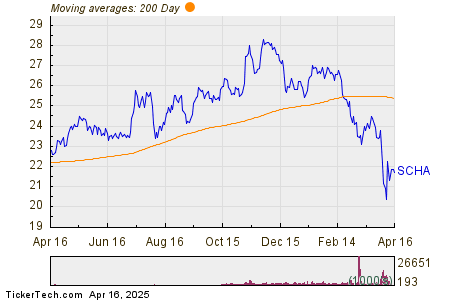Schwab US Small-Cap ETF Sees $205.7 Million Inflow This Week
Today’s analysis of week-over-week changes in shares outstanding reveals significant movements among ETFs. Notably, the Schwab US Small-Cap ETF (Symbol: SCHA) experienced an inflow of approximately $205.7 million. This marks a 1.4% increase in outstanding units, rising from 677,650,000 to 687,050,000.
Among the ETF’s key holdings, Duolingo Inc (Symbol: DUOL) has increased by about 1.6%, while United States Steel Corp. (Symbol: X) is higher by 0.5%. Conversely, Reddit Inc (Symbol: RDDT) has decreased by approximately 1.9%. For a complete overview of the holdings, please visit the SCHA Holdings page.
Price Performance Overview
The chart below illustrates SCHA’s price performance over the past year, compared to its 200-day moving average:

According to the chart, SCHA’s lowest price in its 52-week range was $20.0365 per share, compared to a high of $28.57. The latest trading price stands at $21.75. Analyzing the most recent share price against the 200-day moving average can provide valuable insights for investors. To learn more about this technique, see our article on the 200-day moving average.
Free report: Top 8%+ Dividends (paid monthly)
Exchange-traded funds (ETFs) function similarly to stocks, with investors buying and selling “units” rather than “shares.” These units can be traded freely, but they can also be created or eliminated based on investor demand. Each week, we monitor the changes in shares outstanding, identifying ETFs with remarkable inflows (new units created) or outflows (old units eliminated). The creation of new units necessitates the purchase of the ETF’s underlying holdings, while the destruction of units involves selling these holdings, meaning large inflows and outflows can significantly affect individual components within ETFs.
![]() Click here to discover which 9 other ETFs saw notable inflows this week »
Click here to discover which 9 other ETFs saw notable inflows this week »
Also check out:
- Cheap Technology Stocks
- AFOP Options Chain
- ACK Split History
The views and opinions expressed herein are those of the author and do not necessarily reflect those of Nasdaq, Inc.


